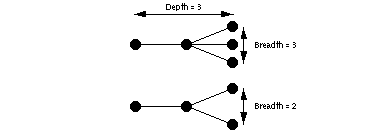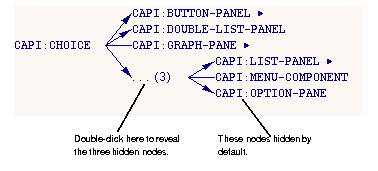






5 Manipulating Graphs
The depth and breadth of a graph are depicted in Figure 5.3.

Figure 5.3 Depth and breadth of graphs
Choose Graph Layout > Maximum Depth to change the maximum depth of graphs in a given tool. The depth of a graph is the number of generations of node which are displayed. Most graphs have a default initial depth of 2, which means that you must expand any nodes you want to investigate by double-clicking on them yourself.
Note that the maximum depth setting is ignored for nodes which you have expanded or collapsed. See Section 5.3 on page 59.
Choose Graph Layout > Maximum Breadth to change the maximum breadth of a given tool. The breadth of a graph is the number of child nodes which are displayed for each parent. If there are more children than can be displayed (the maximum breadth setting is less than the number of children for a given node) an extra node is visible. This node is labeled "...", followed by the number of nodes that remain undisplayed. Double-clicking on this node expands it, allowing you to display the additional children without having to alter the maximum breadth setting for the whole graph. An example of this feature is shown in Figure 5.4 below.

Figure 5.4 Displaying children hidden by the maximum breadth setting
To ensure that all available information is graphed in a given tool, set both the maximum depth and maximum breadth tonil.






Generated with Harlequin WebMaker